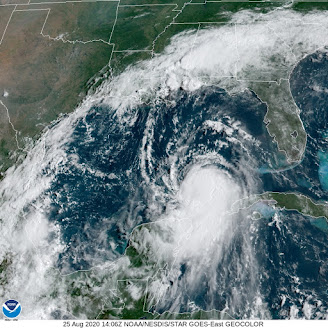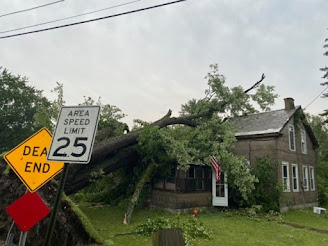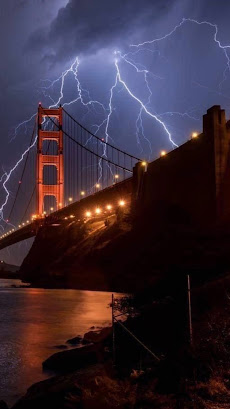Last evening, in the slightly cool air in my garden, I found myself nostalgic and this year, anyway, a little sad over the type of "fair weather" we Vermonters have experienced over the past few days.
 |
Classic "fair weather" last evening in St.
Albans, Vermont. The summer heat has waned,
but autumn chill hasn't hit. Sky has less
buoyant clouds, and the leaves on the trees
are looking tired after a long summer. |
Most people think of fair weather as nice sunshine, with a few pretty puffy clouds, and that's accurate enough. Here in Vermont, fair weather refers to a specific season.
It's that time from about mid-August to mid-September during which the heat of summer is gone, but the chill of autumn is not quite there.
We call it fair season because this interim step before autumn weather comes when most of Vermont has county, regional and state fairs.
It's the kind of weather where you're sweating in a t-shirt on a partly sunny afternoon at the fair as you check out the Tilt A Whirl, go to the animal barn and snack on deep fried onions or something. At night, it cools off enough so that you wear a hoodie to the Grandstand Show.
I don't mean all this to suggest that summer is over. We'll have some more very warm or even hot, humid days. But the end of summer is nigh, as they say.
The weather has been classic fair weather this week, and as mentioned, it made me a little down. Fairs and carnivals aren't happening this year due to coronavirus. We need to enjoy fair weather without the actual fairs this year
So, we turn to nature to enjoy our fair weather. Real fair weather, like the kind we had this week, rarely if ever involves absolutely clear skies. The sun is in and out between the clouds. The clouds themselves are different. You often get the boiling, puffy, towering cumulus or thunderstorms in height of summer. Now, the clouds often seem flatter, less volatile.
Outdoors, it feels hot under the sun, but a cool breeze under the clouds tells you what's coming later in the season
Refreshing breezes blow into the house at night, and for once, the air conditioner is silent, having been turned off. Outdoors, there's splashes of color, and many of the green leaves on the trees just look tired after a long hot summer.
So, maybe take your laptop out on the deck during this fair weather, and enjoy images of county fairs virtually, online. It's the best we can do in these Covid times, unfortunately.
THE TROPICS
Some forecasts are calling for something unseen since 1933: Two simultaneous hurricanes in the Gulf of Mexico.
Sounds extreme, but before you get your panties into a knot, this probably won't work out as forecast. True, there's two systems that have the potential to develop into hurricanes. However, one or both of these budding storms might not get that strong. Or even if they do, their paths might get weird and go off in some odd direction.
 |
This scenario is not super likely but certainly
possible: Two hurricanes at the same time
early next week making landfall
on the U.S. Gulf Coast. |
First the weird paths. Sometimes, when two tropical storms or hurricanes get too close to one another, they dance with each other in something called the Fujiwhara Effect.
When this happens, the two hurricanes rotate around a common pivot point half way between the two storms. Often, if one of the hurricanes is weaker than the other, the weaker will eventually get absorbed into the other.
Regarding the two storms that could affect the Gulf of Mexico, one is coming up from the south, and will cross the Yucatan Peninsula into the western Gulf. The other is coming from the direction of the Puerto Rico and heading toward the Gulf.
Once the two storms get to the Gulf, instead of the two heading straight toward their destinations, the Fujiwhara effect could have the two systems circle each other, creating a really uncertain track forecast.
On top of all that, the outflow from one of the storms could squelch the development of the other. If either or both of these storms turn into hurricanes, this will be one of the toughest forecasts the National Hurricane Center has had to deal with in a long time
To make matters worse, all this would be going on somewhere near the southern United States coast, so the stakes are high here. Stay tuned, it's going to be quite a ride!
SEVERE VERMONT WEATHER?
Vermont is coming off its peak severe weather season, such as it is in these temperate parts. But we still often do see severe thunderstorms this time of year and into September, and there are some low chances of these happening over the next few days.
A weak weather front will be windshield wipering north and south back and forth across Vermont over the next few days. This will be enough to trigger a low, but still real chance of some severe thunderstorms.
NOAA's Storm Prediction Center has a marginal risk of severe storms over Vermont for three days in a row - today, tomorrow and Sunday. Marginal risk means that there is a risk of some isolated, rather short lived bouts of strong to severe storms here and there.
Most of us won't get a severe or damaging storm, but a few places could get a damaging wind gust or two. The risk is highest - if you can call it that - in the northern half of Vermont today and through the state Sunday.
Although August has been wetter than previous months, all of Vermont remains either in moderate drought or is abnormally dry, according to the U.S. Drought Monitor.
The upcoming unsettled weather might help in that regard. However, early indications are most of the rain will fall in the northern half of Vermont. Southern Vermont needs the rain more than the north.























